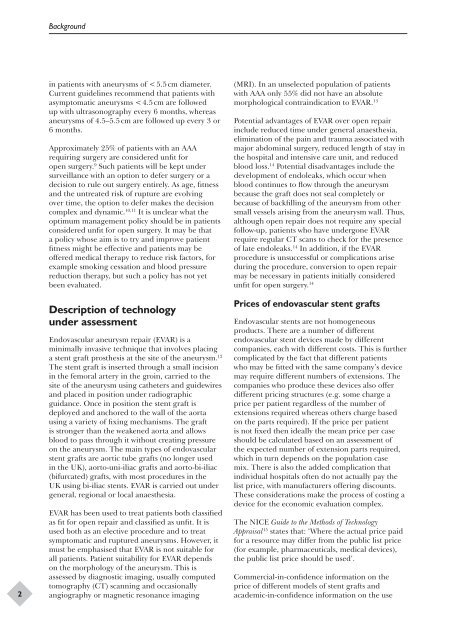Endovascular stents for abdominal aortic aneurysms: a systematic ...
Endovascular stents for abdominal aortic aneurysms: a systematic ...
Endovascular stents for abdominal aortic aneurysms: a systematic ...
You also want an ePaper? Increase the reach of your titles
YUMPU automatically turns print PDFs into web optimized ePapers that Google loves.
Background2in patients with <strong>aneurysms</strong> of < 5.5 cm diameter.Current guidelines recommend that patients withasymptomatic <strong>aneurysms</strong> < 4.5 cm are followedup with ultrasonography every 6 months, whereas<strong>aneurysms</strong> of 4.5–5.5 cm are followed up every 3 or6 months.Approximately 25% of patients with an AAArequiring surgery are considered unfit <strong>for</strong>open surgery. 9 Such patients will be kept undersurveillance with an option to defer surgery or adecision to rule out surgery entirely. As age, fitnessand the untreated risk of rupture are evolvingover time, the option to defer makes the decisioncomplex and dynamic. 10,11 It is unclear what theoptimum management policy should be in patientsconsidered unfit <strong>for</strong> open surgery. It may be thata policy whose aim is to try and improve patientfitness might be effective and patients may beoffered medical therapy to reduce risk factors, <strong>for</strong>example smoking cessation and blood pressurereduction therapy, but such a policy has not yetbeen evaluated.Description of technologyunder assessment<strong>Endovascular</strong> aneurysm repair (EVAR) is aminimally invasive technique that involves placinga stent graft prosthesis at the site of the aneurysm. 12The stent graft is inserted through a small incisionin the femoral artery in the groin, carried to thesite of the aneurysm using catheters and guidewiresand placed in position under radiographicguidance. Once in position the stent graft isdeployed and anchored to the wall of the aortausing a variety of fixing mechanisms. The graftis stronger than the weakened aorta and allowsblood to pass through it without creating pressureon the aneurysm. The main types of endovascularstent grafts are <strong>aortic</strong> tube grafts (no longer usedin the UK), aorto-uni-iliac grafts and aorto-bi-iliac(bifurcated) grafts, with most procedures in theUK using bi-iliac <strong>stents</strong>. EVAR is carried out undergeneral, regional or local anaesthesia.EVAR has been used to treat patients both classifiedas fit <strong>for</strong> open repair and classified as unfit. It isused both as an elective procedure and to treatsymptomatic and ruptured <strong>aneurysms</strong>. However, itmust be emphasised that EVAR is not suitable <strong>for</strong>all patients. Patient suitability <strong>for</strong> EVAR dependson the morphology of the aneurysm. This isassessed by diagnostic imaging, usually computedtomography (CT) scanning and occasionallyangiography or magnetic resonance imaging(MRI). In an unselected population of patientswith AAA only 55% did not have an absolutemorphological contraindication to EVAR. 13Potential advantages of EVAR over open repairinclude reduced time under general anaesthesia,elimination of the pain and trauma associated withmajor <strong>abdominal</strong> surgery, reduced length of stay inthe hospital and intensive care unit, and reducedblood loss. 14 Potential disadvantages include thedevelopment of endoleaks, which occur whenblood continues to flow through the aneurysmbecause the graft does not seal completely orbecause of backfilling of the aneurysm from othersmall vessels arising from the aneurysm wall. Thus,although open repair does not require any specialfollow-up, patients who have undergone EVARrequire regular CT scans to check <strong>for</strong> the presenceof late endoleaks. 14 In addition, if the EVARprocedure is unsuccessful or complications ariseduring the procedure, conversion to open repairmay be necessary in patients initially consideredunfit <strong>for</strong> open surgery. 14Prices of endovascular stent grafts<strong>Endovascular</strong> <strong>stents</strong> are not homogeneousproducts. There are a number of differentendovascular stent devices made by differentcompanies, each with different costs. This is furthercomplicated by the fact that different patientswho may be fitted with the same company’s devicemay require different numbers of extensions. Thecompanies who produce these devices also offerdifferent pricing structures (e.g. some charge aprice per patient regardless of the number ofextensions required whereas others charge basedon the parts required). If the price per patientis not fixed then ideally the mean price per caseshould be calculated based on an assessment ofthe expected number of extension parts required,which in turn depends on the population casemix. There is also the added complication thatindividual hospitals often do not actually pay thelist price, with manufacturers offering discounts.These considerations make the process of costing adevice <strong>for</strong> the economic evaluation complex.The NICE Guide to the Methods of TechnologyAppraisal 15 states that: ‘Where the actual price paid<strong>for</strong> a resource may differ from the public list price(<strong>for</strong> example, pharmaceuticals, medical devices),the public list price should be used’.Commercial-in-confidence in<strong>for</strong>mation on theprice of different models of stent grafts andacademic-in-confidence in<strong>for</strong>mation on the use
















